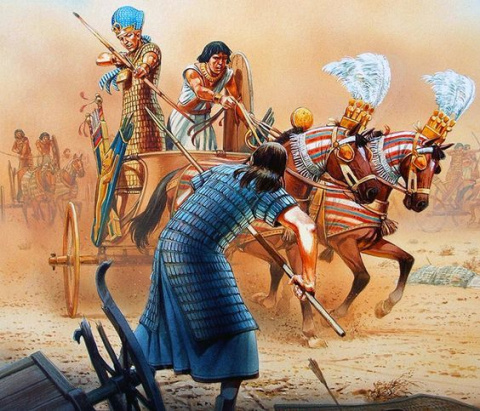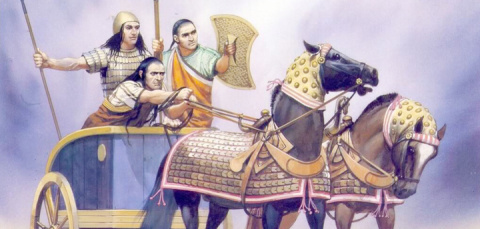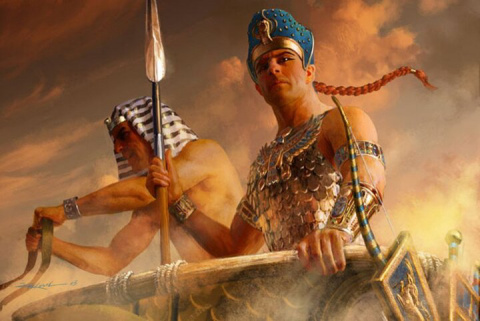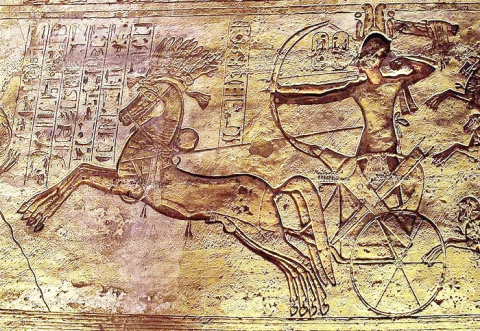1274 року до н.е. хети билися проти єгиптян в одному з найраніших великих битв в історії людства – битві при Кадеші. Шалений жар єгипетських пустель і пронизливий холод вершин країни Хатті танцювали танець смерті на берегах здивованого Оронта, води якого щедро забарвилися кров’ю суперників.
Основою даного опису – першого в історії докладного опису військової битви – є давньоєгипетські та хетські літописи.
Землі Ханаана мали вирішальне значення як хетів, так єгиптян. Обидві сторони активно проводили кампанії по всьому регіону, щоб забезпечити свій військовий контроль та політичний вплив.
Зрештою, це призвело до жорстокої битви, яка сталася при місті Кадеш, на річці Оронт, трохи вище за течією озера Хомс. Сьогодні Кадеш знаходиться неподалік сирійсько-ліванського кордону.
У битві брали участь тисячі солдатів. Це рання зареєстрована битва, для якої відомі такі деталі, як побудова і тактика військ, що дозволяє історикам реконструювати те, що сталося. Також вважається, що битва при Кадеші була однією з найбільших битв на колісницях, що коли-небудь відбувалися на Стародавньому Близькому Сході.
Для єгиптян Ханаан завжди мав вирішальне значення для безпеки та благополуччя. А після того, як єгиптяни вигнали зі своєї вітчизни завойовників-гіксосів, десь близько 1550 до н.е., фараони Нового царства повели більш агресивну кампанію в регіоні.
Вони не лише повернули свої втрачені сфери впливу. Сміливо розширюючи свої кордони, Єгипет вступив у конфлікт із могутніми царствами, такими як Мітанні, Вавилон та Ассирія.
Здолавши цих могутніх ворогів, єгиптяни опинилися віч-на-віч з хетами, які, спочатку, не бажаючи відчути на своїй шиї уславлений хопеш фараонів, навіть прислали їм данину.
Однак, в Єгипті вибухнув релігійно-політичний хаос, внаслідок якого вся їхня близькосхідна “імперія” відпала. Фараони-воїни, які прийшли на зміну шаленим фараонам-реформаторам, розпочали важкий процес повернення втрачених земель.
Хетське царство покладалося на кілька торгових шляхів, що проходять через Сирію та Ханаан, для економічної безпеки своєї держави. Торгівля з Месопотамією мала вирішальне значення, оскільки це був великий ринок збуту хетських товарів.
Єгипетські кампанії в регіоні, в ході яких єгиптяни встановили нові кордони та підкорили князівство Амурру, васала хетів, безпосередньо загрожували стабільності Хетської імперії. Коли хетська армія рушила на південь, її заявленою метою було повернути Амурру.
Єгипетськими військами командував Рамсес II (близько 1303-1213 рр. е.), третій фараон 19-ї династії. До цього він уже воював у Ханаані, Сирії, Нубії та Лівії, а також очолив велику морську експедицію, в ході якої він розгромив піратський флот, який руйнував єгипетське судноплавство.
Хетською армією командував цар Муваталлі II (близько 1310-1265 р. до н.е.). Муваталлі зіткнувся з численними політичними, соціальними та військовими проблемами під час свого правління. Він був майстерним дипломатом, який успішно укладав договори зі своїми сусідами, у тому числі з Вілузою (Трою). Він брав участь у сутичках з народом каска на півночі і мав справу з повстанням Піяма-Раду на заході.
І хети, і єгиптяни зібрали великі армії. Кожна налічувала близько 20 000-50 000 солдатів. Єгипетська армія була розділена на чотири корпуси (Амон, Ра, Сет і Птах) і включала значну частину ханаанських, нубійських, лівійських і шарданських найманців.
До складу хетської армії входили союзні контингенти з Кадеша, Алеппо, Угаріта, Мітанні, Кархеміша, Вілуси (Трої) та кількох інших частин північної та західної Анатолії. Єгиптяни згадують 19 союзних контингентів у хетській армії.
Найбільш важливими контингентами єгипетської та хетської армій були, звичайно, корпуси колісниць. Колісниці бронзової доби були в основному мобільними платформами для лучників і метальників списа, вони не проривалися крізь піхотні формування, як танки. Були також деякі відмінності між хетськими та єгипетськими колісницями. Колеса хетських колісниць розташовувалися в середині колісниці. Це дозволяло їм брати з собою у бій трьох людей: колісничого, лучника та списоносця чи щитоносця.
Для порівняння, єгипетські колісниці мали колеса в задній частині, тому були набагато легшими та маневренішими. Однак, могли перевозити екіпаж із двох осіб: візника та лучника.
Хетти були першими, хто прибув в околиці Кадеша, де вони розташувалися табором за містом, щоб бути поза увагою єгиптян, що наближаються. Потім хети направили численних розвідників, щоб бути в курсі пересування єгипетської армії та… розповсюджувати дезінформацію. У цьому вони досягли успіху: єгиптяни були впевнені, що хети все ще знаходяться в Алеппо, приблизно в 200 км звідси, і надто бояться єгиптян, щоб рухатися на південь. Вважаючи, що хети були далеко, єгиптяни послабили пильність, і підрозділи Амона, Ра, Сета та Птаха на марші розосередилися.
Лише досягнувши Кадеша, єгиптяни захопили в полон двох розвідників, які після жорстокого допиту розкрили місцезнаходження хетської армії. У цей момент Рамсес розбивав табір, у якому були присутні лише підрозділ Амона та його охоронці. Рамзес провів екстрену раду і послав гінців поквапити підрозділи Сета та Птаха. Поки відбувалася ця зустріч, хетські колісниці об’їхали Кадеш і атакували підрозділ Ра, який наближався до єгипетського табору. Підрозділ, не встигнувши навіть побудуватися, кинувся тікати. Битва за Кадеша в цей момент складалася у велику перемогу хетів.
Багато солдатів підрозділу Ра, що біжать, попрямували до єгипетського табору. Хети увірвалися до єгипетського табору і почали мародерствувати, оскільки вважали, що битва вже закінчилася.
Поруч із Рамзесом у цей момент не залишилося майже нікого. Але, змолившись:
“Я кличу до тебе, отче мій Амон, оточений незліченними ворогами, про яких не знав, коли всі чужоземні країни проти мене ополчилися, і я залишився один, і нема зі мною нікого, і покинуло мене військо моє, і відвернулися від мене мої колісничі. Я кричав їм, але не чув, але я не чув, але не чув, але я не чув, але не чув. добріший мені Амон мільйонів воїнів, сотні тисяч колісничих, десяти тисяч братів і дітей, охоплених єдиним поривом серця.
він сподобився допомоги від бога Амона:
“І прийшов Амон, коли я закликав до нього, і простягнув до мене правницю свою, і я радів, і був він як би за мною і переді мною одночасно; і гукнув він мене: “Я з тобою. Я батько твій.
Фараон хоробро кинувся у бій.
Рамсес провів серію контратак проти хетів. Ті були відкинуті назад та змушені відступити.
У цей момент Муваталлі, який все ще мав більшу частину його армії в резерві, особисто очолив ще одну атаку на єгиптян. Але тут прибули воїни із підрозділу Птах. Майже оточені, хети бігли; багато хто з них кинув свої колісниці, щоб перепливти прилеглу річку Оронт у безпечне місце.
Хоча Рамсес зміг вибити хетів із поля бою, він не зміг захопити Кадеш. Крім того, єгипетська армія зазнала таких тяжких втрат, що була змушена повернутися до Єгипту. Хети також були ослаблені та деморалізовані.
Однак обидві сторони сурмили про свою перемогу. Що ж, лише через кілька років наважений Муваталлі зміг вигнати єгиптян із Сирії та спонукати їх васалів у Ханаані до нового повстання. Конфлікт вируватиме ще 15 років, і жодна зі сторін не зможе рішуче перемогти іншу. Зрештою, в 1258 до н.е. єгиптяни та хети уклали договір.
Рамсес, звичайно, зобразив битву при Кадеші як велику перемогу. З іншого боку, Муваталлі описав єгиптян, які з ганьбою повернулися до Єгипту. Більшість сучасних учених вважають, що битва при Кадеші була або нічиєю, можливо тактичною перемогою єгиптян і стратегічною перемогою хетів. Але багато хто виступає за перемогу Єгипту. До речі, після мирного договору Кадеш дістався єгиптянам.
Зрештою, битва при Кадеші призвела до мирного договору між хетами та єгиптянами. Цей договір спочатку був вигравіюваний на срібних табличках, щоб кожна сторона отримала свою копію.
Примітно, що археологи виявили як давньоєгипетську, так і хетську версії договору. Глиняна копія була виявлена в столиці хетів Хаттус і зараз знаходиться в Археологічному музеї Стамбула і в Державному музеї Берліна в Німеччині. Єгипетська версія була написана на стінах двох храмів у Фівах, Рамессеумі та Карнаці. Цей договір є найстарішою міжнародною угодою та найстарішим мирним договором, точні деталі якого відомі.
Договір між хетами та єгиптянами “віщує мир, безпеку, співпрацю та взаємне братерство між двома великими державами”.
Сьогодні копію тексту договору виставлено на видному місці у штаб-квартирі Організації Об’єднаних Націй у Нью-Йорку.
© Times of U




In 1274 BC, the Hittites fought the Egyptians in one of the earliest major battles in human history, the Battle of Kadesh. The fierce heat of the Egyptian deserts and the piercing cold of the Hatti peaks danced a death dance on the banks of the astonished Orontes, whose waters were generously stained with the blood of their rivals.
This description – the first detailed account of a military battle in history – is based on ancient Egyptian and Hittite chronicles.
The lands of Canaan were of crucial importance to both the Hittites and the Egyptians, with both sides campaigning extensively throughout the region to secure their military control and political influence.
This eventually led to a merciless battle that took place at the city of Kadesh, on the Orontes River, just upstream from Lake Homs. Today, Kadesh is located near the Syrian-Lebanese border.
The battle involved thousands of soldiers. It is the earliest recorded battle for which details such as troop formations and tactics are known, allowing historians to reconstruct what happened. The Battle of Kadesh is also believed to have been one of the largest chariot battles ever fought in the Ancient Near East.
For the Egyptians, Canaan had always been of crucial importance to their security and well-being. And after the Egyptians drove out the Hyksos invaders from their homeland, sometime around 1550 BCE, the pharaohs of the New Kingdom began a more aggressive campaign in the region.
Not only did they regain their lost spheres of influence, but by boldly expanding their borders, Egypt came into conflict with powerful kingdoms such as Mitanni, Babylon, and Assyria.
Having defeated these powerful enemies, the Egyptians found themselves face to face with the Hittites, who, at first, not wanting to feel the glorified khopesh of the pharaohs on their necks, even sent them tribute.
However, Egypt fell into religious and political chaos, causing their entire Middle Eastern “empire” to fall away. The warrior pharaohs who replaced the mad reformer pharaohs began the difficult process of reclaiming the lost lands.
The Hittite Empire relied on several trade routes through Syria and Canaan for the economic security of its empire. Trade with Mesopotamia was crucial, as it was a major market for Hittite goods.
Egyptian campaigns in the region, in which the Egyptians established new borders and subjugated the Hittite vassal principality of Amurru, directly threatened the stability of the Hittite Empire. When the Hittite army moved south, its stated goal was to recapture Amurru.
The Egyptian forces were commanded by Ramesses II (c. 1303–1213 BC), the third pharaoh of the 19th dynasty. He had previously fought in Canaan, Syria, Nubia, and Libya, and led a major naval expedition in which he defeated a pirate fleet that was ravaging Egyptian shipping.
The Hittite army was led by King Muwatalli II (c. 1310-1265 BC). Muwatalli faced numerous political, social and military challenges during his reign. He was a skilled diplomat who successfully negotiated treaties with his neighbors, including Wilusa (Troy). He fought skirmishes with the Kaska people in the north and dealt with the Piyama-Radu rebellion in the west.
Both the Hittites and the Egyptians assembled large armies, each numbering between 20,000 and 50,000 soldiers. The Egyptian army was divided into four corps (Amun, Ra, Seth, and Ptah) and included a significant proportion of Canaanite, Nubian, Libyan, and Shardani mercenaries.
The Hittite army included allied contingents from Kadesh, Aleppo, Ugarit, Mitanni, Carchemish, Wilusa (Troy), and several other parts of northern and western Anatolia. The Egyptians mention 19 allied contingents in the Hittite army.
The most important contingents of the Egyptian and Hittite armies were, of course, the chariot corps. Bronze Age chariots were primarily mobile platforms for archers and javelin throwers, they did not break through infantry formations like tanks. There were also some differences between the Hittite and Egyptian chariots. The wheels of the Hittite chariots were located in the middle of the chariot. This allowed them to carry three men into battle: a charioteer, an archer, and a spearman or shield bearer.
By comparison, Egyptian chariots had wheels at the back, making them much lighter and more maneuverable. However, they could carry a crew of two: a driver and an archer.
The Hittites were the first to arrive in the vicinity of Kadesh, where they camped outside the city to be out of sight of the approaching Egyptians. The Hittites then sent out numerous scouts to keep abreast of the Egyptian army’s movements and… to spread misinformation. In this they succeeded: the Egyptians were sure that the Hittites were still in Aleppo, some 200 km away, and were too afraid of the Egyptians to move south. Believing that the Hittites were far away, the Egyptians relaxed their guard, and the divisions of Amun, Ra, Seth, and Ptah became dispersed as they marched.
Only after reaching Kadesh did the Egyptians capture two scouts who, after a brutal interrogation, revealed the location of the Hittite army. At this point, Ramses was setting up camp, with only Amun’s unit and his bodyguards present. Ramses held an emergency council and sent messengers to hurry up the units of Seth and Ptah. While this meeting was taking place, the Hittite chariots circled Kadesh and attacked Ra’s unit, which was approaching the Egyptian camp. The unit, without even having time to line up, fled. The Battle of Kadesh was at this point turning into a great victory for the Hittites.
Many of the fleeing soldiers of Ra’s unit headed towards the Egyptian camp. The Hittites broke into the Egyptian camp and began looting, as they thought the battle was over.
There was almost no one left near Ramses at that moment. But, having prayed:
“I call upon you, my father Amon, surrounded by countless enemies, of whom I knew nothing, when all foreign countries rose up against me, and I was left alone, and there was no one with me, and my army abandoned me, and my charioteers turned away from me. I cried out to them, but not one of them heard when I cried out. And I realized that Amon is more beneficial to me than millions of warriors, hundreds of thousands of charioteers, ten thousand brothers and children, seized by a single impulse of the heart.”
he was granted help from the god Amun:
“And Amon came when I called to him, and he stretched out his right hand to me, and I rejoiced, and it was as if he was behind me and before me at the same time; and he called to me: “I am with you. I am your father. My right hand is above you. Yes, I am more beneficial than a hundred thousand warriors. I am the lord of victory, loving valor.”
The Pharaoh bravely rushed into battle.
Ramesses launched a series of counterattacks against the Hittites, who were driven back and forced to retreat.
At this point, Muwatalli, who still had most of his army in reserve, personally led another attack on the Egyptians. But then the warriors of Ptah’s unit arrived. Almost surrounded, the Hittites fled; many of them abandoned their chariots to swim across the nearby Orontes River to safety…
Although Ramesses was able to drive the Hittites from the battlefield, he was unable to capture Kadesh. In addition, the Egyptian army suffered such heavy losses that it was forced to return to Egypt. The Hittites were also weakened and demoralized.
However, both sides trumpeted their… victory. Well, it was only a few years later that the emboldened Muwatalli was able to drive the Egyptians out of Syria and incite their vassals in Canaan to revolt again. The conflict would rage for another 15 years, with neither side decisively defeating the other. Finally, in 1258 BC, the Egyptians and Hittites made a treaty.
Ramesses, of course, portrayed the Battle of Kadesh as a great victory. On the other hand, Muwatalli described the Egyptians as returning to Egypt in disgrace. Most modern scholars believe that the Battle of Kadesh was either a draw, perhaps a tactical victory for the Egyptians and a strategic victory for the Hittites. But many argue for an Egyptian victory. Incidentally, after the peace treaty, Kadesh did go to the Egyptians.
Ultimately, the Battle of Kadesh resulted in a peace treaty between the Hittites and the Egyptians. This treaty was originally engraved on silver tablets so that each side would have its own copy.
Remarkably, archaeologists have discovered both the ancient Egyptian and Hittite versions of the treaty. A clay copy was discovered in the Hittite capital of Hattusa and is now housed in the Istanbul Archaeological Museum and the Berlin State Museum in Germany. The Egyptian version was inscribed on the walls of two temples in Thebes, the Ramesseum and Karnak. The treaty is the oldest international agreement and the oldest peace treaty whose exact details are known.
The treaty between the Hittites and the Egyptians “proclaims peace, security, cooperation and mutual brotherhood between the two great powers.”
Today, a copy of the treaty text is prominently displayed at the United Nations headquarters in New York.
© Times of U

